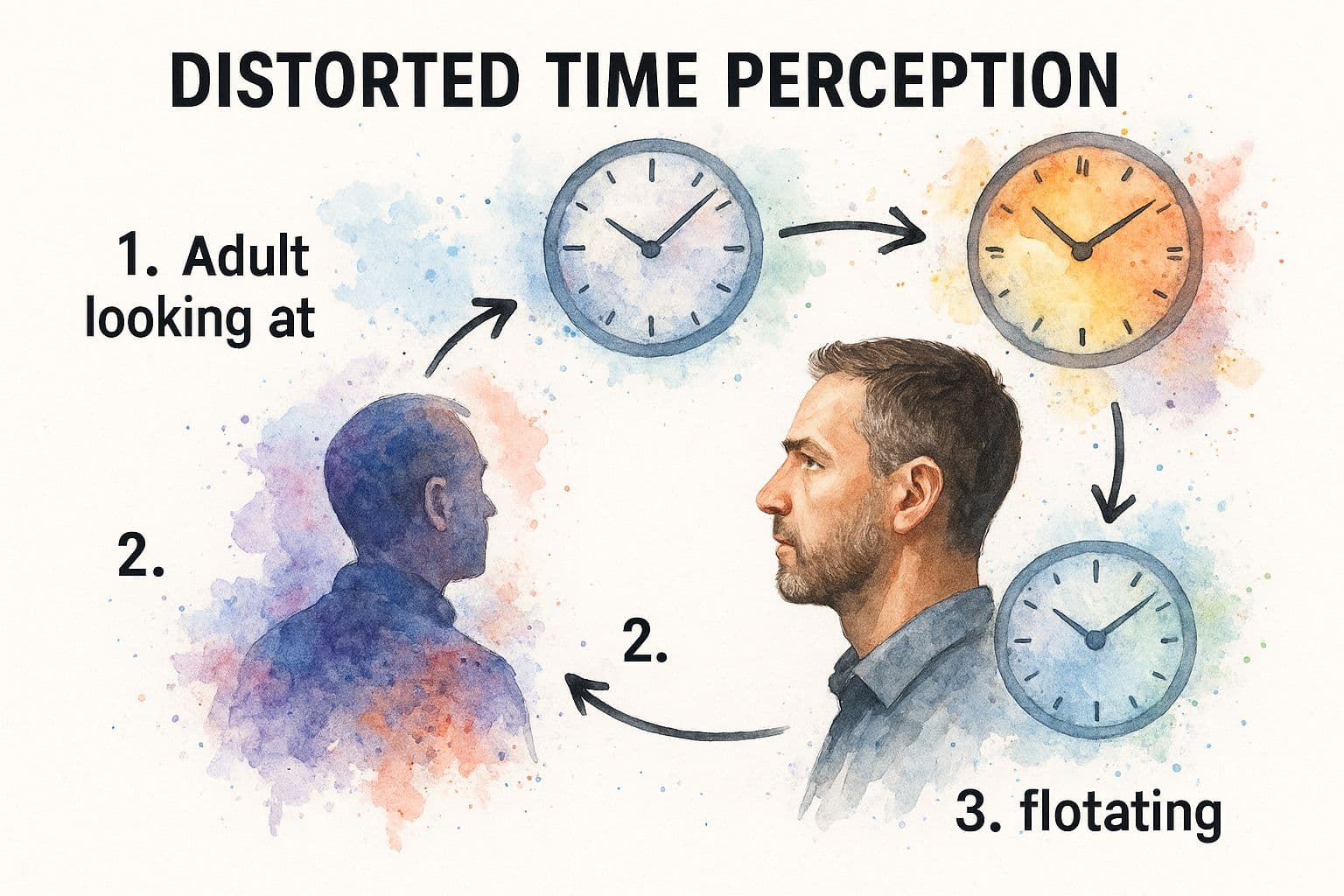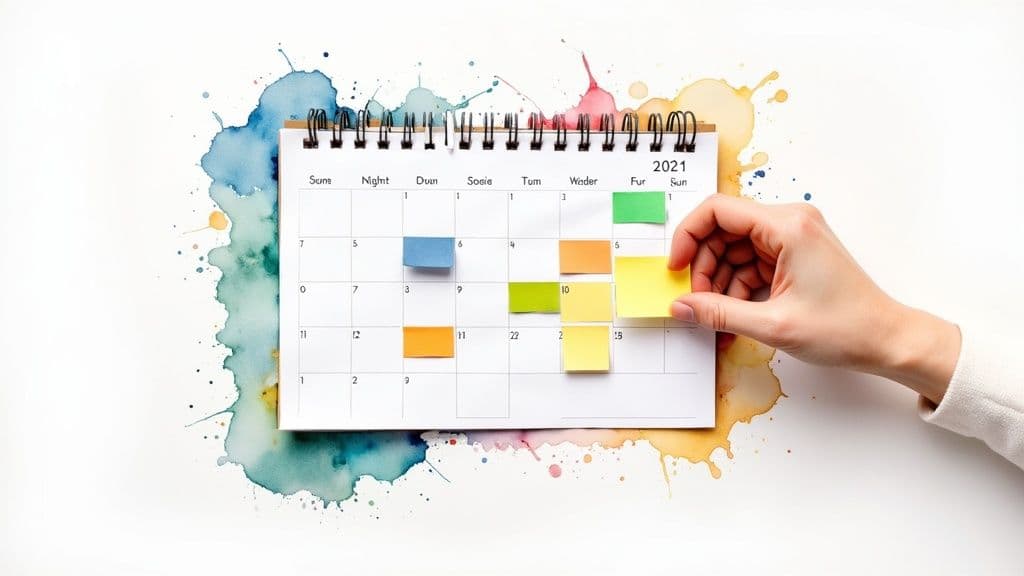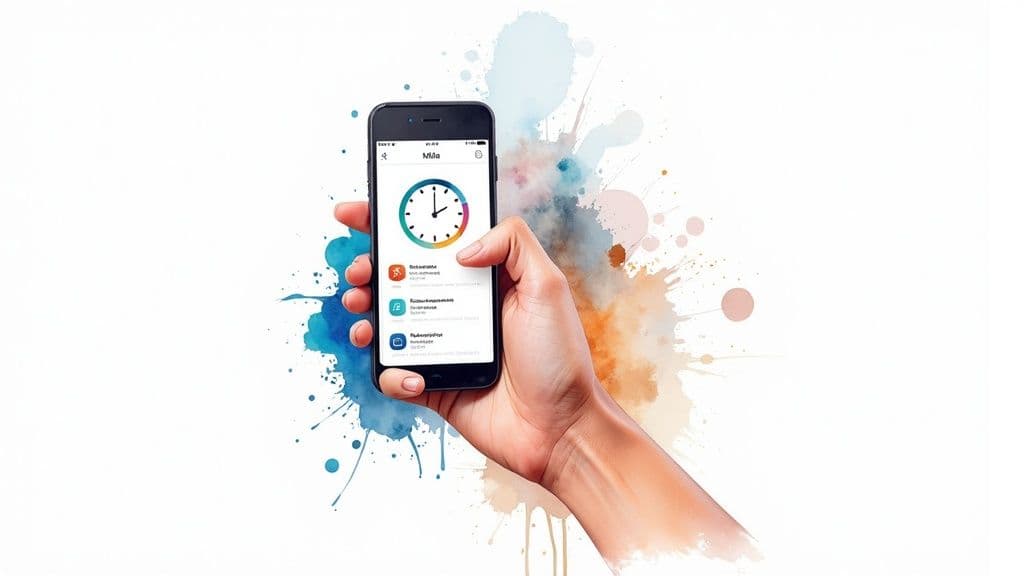Struggling with time management for adults with ADHD? Discover proven strategies tailored to your needs for better focus and productivity. Click to learn more!
July 6, 2025 (6mo ago)
Effective Time Management for Adults with ADHD | Tips That Work
Struggling with time management for adults with ADHD? Discover proven strategies tailored to your needs for better focus and productivity. Click to learn more!
← Back to blog
If you're an adult with ADHD, you've probably heard all the standard productivity advice—and felt like a failure when it didn't stick. Let me tell you from experience: you're not failing. The system is failing you.
When it comes to time management for adults with ADHD**, we need a completely different playbook. The goal isn't to force your brain to work like everyone else's but to create a system that plays to its unique strengths and supports its challenges.
Why Traditional Time Management Fails for ADHD
The deep-seated frustration so many of us feel isn't about a lack of effort or willpower. It's a fundamental mismatch between the rigid, linear world of conventional productivity and the dynamic, non-linear nature of an ADHD brain. Most advice is built on the assumption that time is a predictable resource, which couldn't be further from the truth for many of us.
The Challenge of Time Blindness
One of the biggest hurdles is something called time blindness. It's the persistent difficulty in sensing the passage of time. For me, and many others with ADHD, time often exists in two states: "Now" and "Not Now." This makes it incredibly difficult to guess how long a project will take or to get started on something that isn't due immediately.
Ever thought you'd just do five minutes of "quick work," only to look up and see an hour has vanished? That's time blindness in action, and it can throw off an entire day's schedule. It's not a personal weakness; it's a real neurological difference in how the brain registers and interprets time.
Navigating Executive Function Hurdles
Beyond the clock, ADHD directly impacts our executive functions—the brain's command center for planning, organizing, and getting things done. These aren't just minor quirks; they're significant roadblocks that can make productivity feel like an uphill battle.
Here’s what we’re often up against:
- Sustained Attention: Staying focused is tough, especially if the task isn't new, urgent, or fascinating.
- Task Initiation: The mental energy it takes just to start something can feel monumental, which is why procrastination is so common.
- Working Memory: Trying to hold multiple steps or details in your head at once can lead to feeling completely overwhelmed.
- Emotional Regulation: When frustration or boredom hits, the impulse to just drop everything can be powerful.
This combination creates a perfect storm where even the most detailed plans can quickly unravel. Research backs this up. A 2015 study showed that adults with ADHD have significant issues with sustained attention, and these challenges actually increase the longer a task goes on. You can explore the full study on neuropsychological performance to dig deeper into the science.
The answer isn't to just "try harder" with tools that were never designed for you. It's about building a personalized system that provides the external scaffolding your brain needs to shine.
So, how do we get there? It starts with acknowledging that the old advice just won't cut it.
Traditional vs. ADHD-Friendly Time Management Approaches
Traditional productivity tips often feel like they were written for a different operating system. Here’s a look at why they fall short and what works better for an ADHD brain.
| Traditional Advice | ADHD-Friendly Alternative | Why It Works |
|---|---|---|
| "Just make a to-do list and stick to it." | Use a "might-do" or "menu" list categorized by energy level. | Provides options and reduces the pressure of a rigid, all-or-nothing list. |
| "Eat the frog—do the hardest task first." | "Eat the dessert first"—start with a quick, rewarding win. | Builds momentum and releases dopamine, making it easier to tackle bigger tasks. |
| "Plan your whole week in advance." | Plan just one or two days ahead in detail. | Reduces overwhelm and accommodates the "now/not now" perception of time. |
| "Avoid distractions at all costs." | Use "body doubling" or work in a moderately stimulating environment. | Provides gentle accountability and external stimulation that can actually improve focus. |
| "Break down big projects into small steps." | Break projects into tiny, visible, and immediately actionable steps. | Overcomes task initiation paralysis by making the first step feel ridiculously easy. |
By shifting your mindset from one of self-blame to one of strategic support, you can finally start building a time management system that feels less like a chore and more like a true partner in your success.
Ultimately, managing time effectively with ADHD is about building an entirely new toolbox. It’s about leaning on external aids, creating visual roadmaps, and finding strategies that give your brain the novelty, clarity, and immediate feedback it craves. Once you accept these differences, you can leave the guilt behind and start creating a life that works for you.
Build Your External Brain to Reduce Mental Clutter
Let's be honest, trying to use the ADHD brain as a storage unit is a recipe for disaster. It's like asking a world-class sprinter to be a filing cabinet. Our minds are built for connecting ideas and creative problem-solving, not for remembering every single appointment, grocery list item, and random 2 AM brilliant thought.
The most powerful change I ever made was to stop trying to hold it all in my head. Instead, I built an "external brain"—a trusted system outside of myself to catch everything. This isn't just about a fancy to-do list; it's about systematically offloading the mental noise that fuels so much of our stress and anxiety. The goal is to create one central spot for everything, freeing up your mind to actually think.
Create Your Central Brain Dump
First things first: you need a single, reliable place to dump every thought, task, and idea the second it pops into your head. Immediate capture is everything. If you wait, even for a minute, you risk that thought vanishing into the ether, replaced by the next shiny thing. This is where a tool like Fluidwave comes in, acting as your digital inbox.
The trick is to make it completely frictionless. Whether it’s a brilliant new business concept or a mundane reminder to buy milk, it all goes into the same place. This removes the mental hurdle of deciding where to put something, which can be a major point of paralysis.
This image really drives home why this is so critical. For many with ADHD, our internal sense of time is... well, unreliable. This "time blindness" makes an external system not just a nice-to-have, but an absolute necessity.

Without an external anchor, it’s easy to feel adrift.
How to Organize Your Brain Dump for Clarity
Okay, so you've dumped everything out of your head. Now you're staring at a massive, terrifying list. This is just as overwhelming as a cluttered mind, right? The magic happens next, when you bring some order to the chaos. A flexible system is your best friend here, because it lets you sort information in a way that actually clicks with your unique brain.
I've found a few simple tagging methods to be incredibly effective. They turn that wall of text into something you can actually work with.
- By Energy Level: Let's face it, not all tasks require the same brainpower. I tag things as
#high-energy(like drafting a big proposal) or#low-energy(like cleaning out my inbox). This lets me match my to-do list to how I'm actually feeling. - By Context: This one is a game-changer for efficiency. Using tags like
@computer,@errands, or@phonehelps you group tasks you can knock out all at once. No more running around—you can tackle all your phone calls in one go. - By Urgency: A simple
#urgenttag is a lifesaver. It helps the truly critical stuff float to the top so you don't have to re-read your entire list 15 times a day to figure out what's on fire.
When you create a system you truly trust, that low-level hum of anxiety—the one that comes from trying to remember everything—finally quiets down. This is the core of effective time management for ADHD: externalizing your working memory.
Here’s a look at how you can get this organized visually in Fluidwave. It's about turning that chaotic brain dump into a clear, actionable plan that supports your professional and personal goals.

Ultimately, this system becomes more than a task manager; it’s a reliable partner. It holds onto the "what" so you can finally focus your energy on the "how" and "when." Building this habit—immediate capture, thoughtful organization—is one of the most impactful things you can do to lower your cognitive load and feel more present and productive.
Turn Your Master List Into a Realistic Daily Plan
That massive "brain dump" list? It’s both a blessing and a curse. Getting everything out of your head is a huge relief, but staring at that wall of text can trigger instant paralysis. For those of us with ADHD, the real magic happens when we can turn that master list into something we can actually get done today.
This is where most systems fall apart—in the messy transition from a chaotic brain dump to a focused, actionable plan. What you need is a simple, repeatable ritual to bring clarity to your day without getting overwhelmed before you even start.
Choose Your “Must-Do 3”
Let’s keep it simple. Scan your master list—maybe the one you built in a tool like Fluidwave—and pick just three things. That’s it. These are your non-negotiables for the day.
If you get these three things done, you can count the day as a win. This isn't about ignoring everything else on your plate. It's about giving your brain a clear, achievable target to lock onto. The "Must-Do 3" method cuts through the noise and provides an immediate sense of direction. Anything else you finish is a bonus, which helps reframe your day around what you did accomplish, not the endless list of what you didn't.
Choosing just three tasks prevents decision fatigue and provides an anchor for your day. It transforms the vague anxiety of "I have so much to do" into the concrete, manageable goal of "I need to do these three things."
Once you've got your priorities straight, it's time to make them real by giving them a home on your calendar.
Use Time Blocking to Create a Visual Roadmap
Time blocking is a game-changer if you struggle with time blindness. Instead of just knowing what you need to do, you decide when you'll do it and for how long. You're essentially making appointments with your tasks.
Here’s what that might look like in practice:
- Block 1 (9:30 AM - 10:30 AM): Draft the project proposal.
- Block 2 (1:00 PM - 1:45 PM): Follow up on client emails.
- Block 3 (3:00 PM - 3:30 PM): Outline the team meeting agenda.
See the buffer time built in? It’s crucial to also schedule your breaks, lunch, and even the little transition periods between tasks. This helps you sidestep that classic ADHD trap of underestimating how long things take and creating a schedule that’s doomed from the start. A visual layout on a calendar makes your plan concrete and far easier to stick to than an abstract to-do list.
Adopting a structured system like this is more than a productivity hack; it's a way to train your brain. Research into cognitive behavioral therapy for adults with ADHD consistently shows that structured time management programs lead to significant, lasting improvements. These systems provide the external scaffolding we need to strengthen our own executive function skills. You can read the full study on time management interventions to dig deeper into the science.
Ultimately, this isn't about boxing yourself in. It's about creating a predictable structure that finally gives you the freedom to thrive.
Winning the Fight Against Procrastination and Distraction

Even with the most meticulously crafted plan, the real challenge for adults with ADHD often comes down to the moment of action. That’s when task initiation paralysis can hit—that frustrating feeling of being stuck, unable to start. Combined with the constant siren call of distractions, it can easily sabotage your best-laid plans.
The key isn't to fight your brain's wiring but to work with it. One of my go-to methods, and one that has worked wonders for countless others, is the Pomodoro Technique. It’s brilliantly simple: work in focused 25-minute sprints, followed by a short break.
This approach works on two levels. First, telling yourself "I just need to focus for 25 minutes" feels infinitely more manageable than staring down a three-hour project. It lowers the mental barrier to getting started. Second, the built-in timer creates a sense of urgency and structure that the ADHD brain often needs to engage.
Engineer a Distraction-Free Zone
Your environment—both physical and digital—plays a massive role in your ability to concentrate. The idea is to make doing the right thing as easy as possible. A clear desk is a good start, but your digital space is just as important.
Here are a few practical steps you can take right now:
- Silence the noise. Turn off every non-essential notification on your computer and phone. Each ding or pop-up is a potential rabbit hole.
- Use blocking apps. I’m a big fan of tools like Freedom or Forest. They act as a digital gatekeeper, blocking distracting sites and apps so you can get into a state of flow.
- Send a "do not disturb" signal. If you work around others, pop on a pair of headphones. It’s a universal sign that you’re in deep work mode.
Proactively setting up your space is a core tenet of effective time management for adults with ADHD. You’re removing the temptation before it even has a chance to pull you away.
Use Accountability and a "Parking Lot" for Ideas
Have you ever noticed it’s easier to stay on task when someone else is in the room, even if they aren't interacting with you? That’s the magic of body doubling. This simple accountability trick, whether done with a colleague in person or a virtual group online, provides a gentle external pressure that can help you stay grounded.
Here's a crucial mindset shift: Interruptions are inevitable. The goal isn't to eliminate them completely, but to have a system for dealing with them quickly so they don't derail your entire day.
Of course, the biggest distractions often come from within your own mind. A brilliant idea for a different project, a sudden memory of an email you forgot to send—these thoughts can hijack your focus.
Don't let them. Instead of following that new thought, have a "parking lot" ready. For me, that's a dedicated "brain dump" list in Fluidwave. I can quickly type out the thought and trust it's been captured, freeing my mind to return to the task at hand. If you want to dive deeper into this, our guide on how to avoid distractions at work has more great tips.
Taming the Titans: Strategies for Big Projects and Long-Term Consistency

It’s one thing to nail a daily to-do list, but what about those massive, intimidating projects? You know the ones—the "finally launch the new website" or "completely overhaul the garage" kind of goals. They feel so huge that starting them seems impossible.
This is where true time management for adults with ADHD goes beyond daily hacks and into long-term strategy. It's about building a reliable system that generates its own momentum, helping you see those big ambitions through to the finish line.
The need for this kind of support is massive. An estimated 404 million adults worldwide are navigating ADHD, with over half of diagnoses in the US happening in adulthood. That means millions of people are trying to manage these hurdles without the right game plan. You can see more on this in the latest ADHD stats for 2025 on jilljohnsoncoaching.com.
Use Chunking to Break Down Overwhelming Goals
When faced with a big project, the ADHD brain often perceives it as a single, terrifying monolith. "Organize the garage" isn't a task; it's a source of instant overwhelm. The secret is to break it down into ridiculously small, almost laughably easy pieces. This is a technique called chunking.
Instead of one giant goal, you create a checklist of tiny, specific actions. Let's take that garage project. It might look like this:
- Step 1: Grab one trash bag and fill it.
- Step 2: Move the bikes to the driveway.
- Step 3: Sort through just one box of old holiday decorations.
Each of these mini-tasks is easy to start and, more importantly, quick to finish. That gives you a small but powerful hit of accomplishment. In a tool like Fluidwave, you can log these as individual tasks, turning a vague, scary goal into a clear, step-by-step plan you can knock out one item at a time.
A weekly review is a non-negotiable appointment with yourself. It's where you clear the clutter, reset your priorities, and ensure your system continues to serve you instead of becoming another source of overwhelm.
Make a Consistent Weekly Review Your Anchor
To stay on track for the long haul, you absolutely need a dedicated time to zoom out and reset. Think of the weekly review as your anchor. It’s a 30-60 minute block you schedule every single week—I find Friday afternoons or Sunday evenings work best—to get your external brain organized again.
Your weekly review doesn’t need to be complicated. Keep it simple and focused:
- Clear the Decks: Process anything lingering in your email, on your desk, or in your notes app. Get it all into your system.
- Look Back: Glance over your completed tasks from the past week. What went well? Where did you get stuck? Don't forget to celebrate the wins, no matter how small.
- Plan Ahead: Look at your calendar and master task list for the coming week. Decide on your top 3 priorities for Monday and block out time for important appointments or deep work.
This simple ritual prevents things from falling through the cracks and allows you to start every week with a clean slate and a clear sense of direction. You can find more powerful techniques like this in our complete guide to ADHD time management strategies.
Harness Dopamine with Strategic Rewards
Let's be honest—the ADHD brain is wired to seek out novelty and rewards. So, instead of fighting that instinct, why not work with it? Build rewards directly into your workflow to create a positive feedback loop that your brain will thank you for.
This isn't about grand gestures. It’s about small, immediate payoffs.
Finished a task you were dreading? Great, you've earned 15 minutes of guilt-free scrolling. Completed your weekly review? Time to order your favorite takeout for dinner.
By linking effort to an immediate, positive outcome, you give your brain the dopamine it craves. This simple shift makes it so much easier to stay engaged and maintain consistency, even when the finish line feels miles away.
Have a Question? Let's Troubleshoot
Even with a solid game plan and the right tools, you're going to hit a bump in the road. That's not just okay; it's expected. Mastering time management for adults with ADHD isn't about creating a perfect, unbreakable system. It's about knowing what to do when things—inevitably—go sideways.
Let's walk through some of the most common snags I see people run into.
"I Totally Fell Off the Wagon. Now What?"
First, take a deep breath and give yourself some grace. This isn't a moral failure. It's just your brain doing its thing. The real win isn't avoiding the fall; it's shortening the time it takes to get back up.
Resist the urge to play catch-up. Staring at a mountain of overdue tasks is a one-way ticket to overwhelm. Instead, declare "task bankruptcy" on yesterday. Just write it off. Open your planner, look at what’s on for today, and find one small thing to tackle.
The most crucial step isn't analyzing why you got derailed. That can come later. The priority is to take one tiny action to regain momentum. You can’t afford to wait for that.
"My Schedule Is All Over the Place. How Can This Work for Me?"
An unpredictable schedule can feel impossible to manage. The secret here is to stop trying to force a rigid, hour-by-hour calendar onto a life that doesn't fit that mold. You need flexibility, not fragility.
Instead of slotting tasks into specific times days in advance, think of your to-do list as a "menu" you can order from. The key is tagging everything with context. I always suggest my clients start with these:
- Energy Level: Use tags like
#BrainDead,#FullPower, or#Wired. - Time Available: Tag tasks with
#5-MinWin,#30-MinFocus, etc. - Context: Add tags like
#AtMyDesk,#OnTheGo, or#WaitingForReply.
When a 20-minute gap unexpectedly opens up, you don't have to waste energy deciding what to do. Just filter your list for a task that fits the time and energy you have right now. This approach gives you structure without the brittleness of a traditional schedule.
"I Was Doing Great, but My Motivation Completely Vanished. Help!"
Ah, motivation. It's a fun visitor, but for the ADHD brain, it’s a terribly unreliable roommate. If your system depends on feeling motivated, it's doomed to fail. We need to build a system that runs on routine and habit instead.
Your planning session needs to become as automatic as brewing your morning coffee. In fact, why not literally tie it to that? While the coffee brews, you review your list and pick your "Must-Do 3" for the day. This is called habit stacking, and it works.
Also, make your progress impossible to ignore. A visible "done" list or even just seeing the checkmarks pile up in Fluidwave creates a powerful feedback loop. Seeing what you’ve accomplished is a far more sustainable fuel source than waiting for the lightning bolt of motivation to strike.
Focus on What Matters.
Experience lightning-fast task management with AI-powered workflows. Our automation helps busy professionals save 4+ hours weekly.